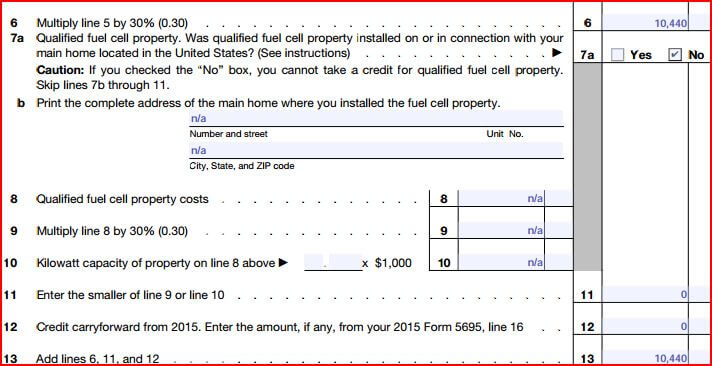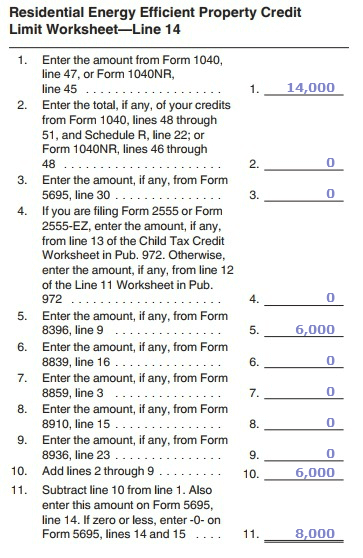A residential solar energy system is one of the best ways to lower your electricity costs. Federal, state, and local organizations have established incentive and rebate programs to lower the cost of installation. The hope is to encourage more solar systems installed for homes and businesses. The IRS offers a Federal Income Tax Credit (ITC) on solar power systems. The Solar ITC allows home and business owners to deduct 30% of the cost of installing solar from their federal income tax. In effect, that means a 30% savings off of the list price.
To make it easier, let’s put some numbers to it. The average cost of installing a solar panel system in California is around $25,000. At that price, the solar tax credit can reduce your federal tax burden by $7500. If your total tax burden were $10,000, the IRS would allow the remaining $2,500 to be carried over to the following year.
Step 1: Check Your Eligibility
You must own your solar energy system to be eligible for the Federal Income Tax Credit. If you lease your solar paneling system, then you will not qualify for the Federal ITC.
Step 2: Complete IRS Form 5695
If you would like to get started right away you can download the 2018 IRS Form 5696 here and this form provides instructions on how to fill out the 5695 form.
How To Fill Out IRS Form 5695
KEEP IN MIND: We are solar guys, not tax guys. We do not give tax advice, and anything you read on this page is merely one example of how someone might act. Please consult a tax professional before filing.
The 5695 Form is for Residential Energy Credits. With some simple math and double-checking of your receipts, you’ll include your final tally on Line 53 of IRS Form 1040. To make the example simple, we’ll use the following numbers:
-
- First time buying a solar power system, no other energy efficiency improvements or fuel cell equipment
-
- Solar installation cost = $34,800
-
- Total tax burden = $14,000
-
- Mortgage interest credit = $6,000
-
- No alternative minimum tax not selected
- No credits for healthcare premium payments, for child care expenses, for foreign taxes, for retirement savings contributions, or for education.
Filling out Form 5695
The IRS Form 5695 will calculate residential energy credits from 2 parts: residential energy efficient property credits and nonbusiness energy property credits. The Residential Energy Efficient Property Credit will calculate total solar savings minus any other purchases you’ve made throughout the year. Nonbusiness Energy Property Credits include any energy efficient improvements to your residence. The 2 parts will be added together and included on Line 53 of Form 1040.
-
- Line 1 (“qualified solar electric property costs”): Total gross cost of your solar energy system (minus any cash rebates). This cost is one the receipt provided by your solar installation contractor.
-
- Line 5: Sum total of adding Lines 1 through 4.

- Line 5: Sum total of adding Lines 1 through 4.
-
- Line 6: Multiply Line 5 number by 30%. This is the total of the solar federal tax credit.

- Line 6: Multiply Line 5 number by 30%. This is the total of the solar federal tax credit.
-
- Line 12: If this is your first year applying for the ITC, put in “0”. Enter it here If you filed for a solar tax credit last year and have a remaining rollover credit,.
-
- Line 13: Sum total of adding up Lines 6, 11, and 12.

- Line 13: Sum total of adding up Lines 6, 11, and 12.
-
- Line 14: Put aside Form 5695 to do some side calculations on whether or not there are any limitations on your solar ITC. The side calculations can be done using the “Residential Energy Efficient Property Credit Limit Worksheet” on Page 4 of 5695 Instructions. Your worksheet calculations will be put on Line 14.You’ll need to include any tax credits for the elderly or the disabled, mortgage interest credit, first-time homebuyer credit, or buying a plug-in hybrid or electric vehicle. In our example, we only had a credit for mortgage interest, so our tax credit limitation is $8,000.

- Line 14: Put aside Form 5695 to do some side calculations on whether or not there are any limitations on your solar ITC. The side calculations can be done using the “Residential Energy Efficient Property Credit Limit Worksheet” on Page 4 of 5695 Instructions. Your worksheet calculations will be put on Line 14.You’ll need to include any tax credits for the elderly or the disabled, mortgage interest credit, first-time homebuyer credit, or buying a plug-in hybrid or electric vehicle. In our example, we only had a credit for mortgage interest, so our tax credit limitation is $8,000.
-
- Line 15: Compare Line 13 to Line 14. Write in smaller of the two values on Line 15.
- Line 16: In our example, this is our first year to claim the solar tax credit. So we’ll put “0” in the box since there is nothing carried over from the previous year. If your tax liability is smaller than your tax credits, subtract Line 15 from Line 13. Write this total on next year’s taxes.

Step 3: Add Renewable Credit Information to Your 1040
Write in total on Line 15 of Form 5695 into Line 53 of Form 1040. And that’s it!
If you’ve never claimed any solar panel installation tax credit before, then the calculations are quite simple and straightforward. The solar tax credit adds a minimal amount of extra effort for what could be a lot of savings on your final tax burden. Every homeowner who’s invested in a solar energy system should take advantage of this fantastic government incentive. We suggest you review this information with your tax expert before filing.
If you have any questions, give us a call at 805-772-6786. Or connect with one of our solar specialists. We’ll be happy to share more information about solar tax credits.

